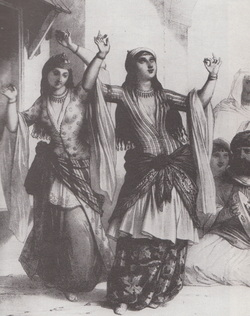
Though many dancers incorporate full orchestras with well-known musical instruments like violins in their repertoire, purists are aware of the ancient Arabic instruments.
Qanun
The Qanun is a very popular stringed instrument used in Arabic music. It is related to the zither and is a descendant of the Egyptian harp. It is recognized by its narrow trapezoidal soundboard and is set on the lap for playing. Strings (the Turkish style has 26 course of strings, 3 strings per course) are of gut or nylon and not metal. They are plucked or stoked, depending on the desired sound. Stroking gives a more flowing sound. The musician uses small bone quills attached to the index fingers with metal rings. Pitch can be raised or lowered through the use of levers.
Santur (Santir)
The Santur is a hammer dulcimer, known as the “Persian dulcimer.” Smaller that the qanun, it is a long-necked, 3-stringed lute. Leather bands are used for tuning. It’s played by striking the strings with wooden mallets (hammers).
Ud (Oud)
Probably the most well-known and oldest (dating back over 5,000 years) of Arabic instruments for its rich, mellow sound. It is related to the lute, lyre and harp. A guitar-like stringed instrument, it features a large pear-shaped belly, short fingerboard and a head with wooden pegs for tuning. It is played with an Eagle feather in Persia or with bone or plastic (plectrum/barbat) in other Arabic cultures.
Saz
Though it originated in West Asia, the Saz is popular in Iran and especially in Turkey. This chordophone, long-necked lute, is the most important instrument in Turkish folk music. It has a pear-shaped belly with a long fingerboard with tuning pegs at the head and is plucked with a plectrum.
Bouzoukee
Another lute-like instrument found in Greece and similar to the Ud and Saz. It is similar to a mandolin but has a lower pitch. Its pear-shaped belly is often inlaid with mother-of-pearl. Depedning on the type, there are varied string configurations. It is also played with a plectrum and known for its rich tone and resonance.
Nay
The Nay is basically a flute created from a long piece of cane. With a metal mouthpiece, it has six finger holes in front and one in back. With its haunting sound, it has been made famous by snake charmers and dancers prefer it for slow, sensuous, snake-like taxsim.
Doumbek (Doumbeki)
The Doumbek is a type of drum (tabla) is probably the most important and most prominent in Arabic music. It is the heartbeat of Middle Eastern dance, keeping the rhythm and tempo. It is a goblet-shaped, hand-held drum molded from clay, metal or carved wood. The top/head is larger than the open bottom and is fitted with shark or goat skin.
 RSS Feed
RSS Feed